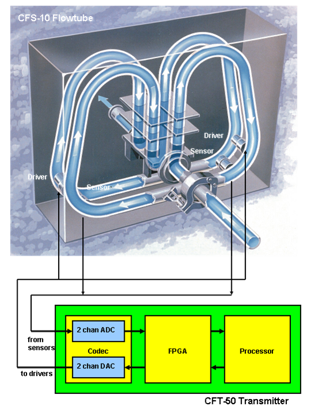Coriolis Research, Advanced Instrumentation Research Group
Coriolis Research
Introduction
Coriolis mass flow metering is a well-established technique for industrial flow measurement. A coriolis meter consists of a vibrating flowtube through which the process fluid passes, and a transmitter which causes the flowtube to vibrate and which extracts mass flow and density information. Direct measurement of mass flow is advantageous in applications where commodity value is related to mass rather than volume, for example in the petrochemical industry. However, Coriolis meters offer many benefits, including high accuracy (to 0.1% for static flow rates), and good turndown (100:1 or better), while their limitations include the need for a separate power supply, relative expense and vulnerability to aerated fluids. A user perspective on Coriolis as an “almost perfect” flowmeter is given in [1].

The UTC has been in the forefront of developments in Coriolis Mass Flow meter, researching issues such as fast dynamic response and two-phase and multiphase flow.
As well as numerous papers, the UTC has over 20 patents on Coriolis metering technology (see our publications section), and was awarded the Wheatstone Measurement Prize in 2007.
Reference:
[1] Reizner, J. R:, Coriolis – The Almost Perfect Flow Meter. IEE Computing & Control Engineering, Vol. 14, Issue 4, pp 28-33, Aug 2003.
